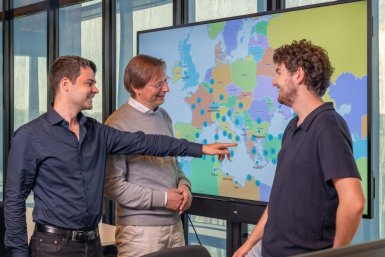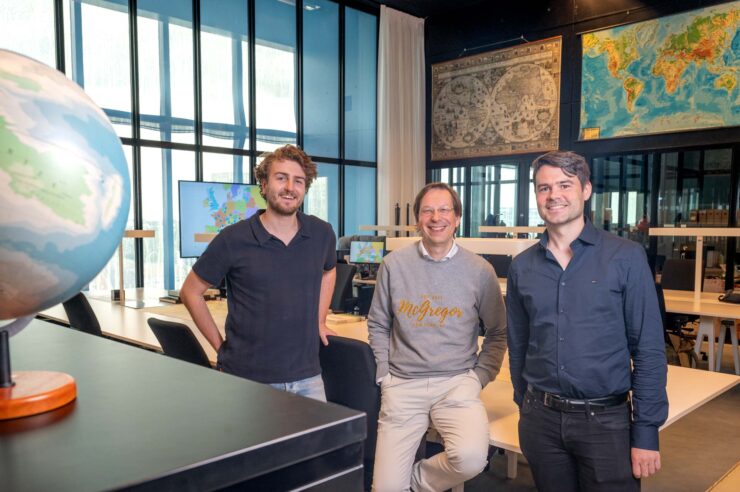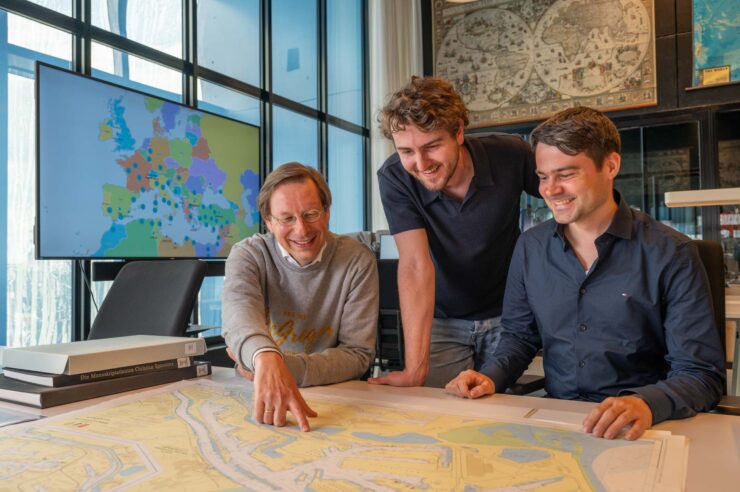Interview with Tijmen Baarda (CDH), Leonard Rutgers & Stefan Dingemans: interactive map of Jewish migration in Europe in Roman times

“Digital research is the future, also in humanities”
Professor Leonard Rutgers and his colleagues research how Jewish migrants spread over Europe in Roman times. Thanks to a grant of the FAIR Research IT programme, the team was able to digitise a large number of sources and incorporate them into an interactive map. Other scholars can now use that map for their research.
When you are researching the Roman period, says Leonard Rutgers, you need to be lucky with the sources that have been handed down: books, inscriptions, what is left of buildings. “Often it is a Swiss cheese. Fortunately, many sources on Jewish communities have survived. That is why we know that Jews were already living in Europe two thousand years ago.”
As a professor of Late Antiquity, Leonard Rutgers is concerned with the historical spread of the Jewish people across our continent. `This group has kept its own identity throughout the centuries and can therefore be traced. As opposed to other migrant groups in Antiquity which cannot be traced in an archeological sense within two to three generations. My colleagues and I wanted to take the next step in our research: what underlying patterns can be recognized in Jewish migration?”
Playing with data
The team applied for a grant at Utrecht University FAIR Research IT Innovation Fund (see text box). With the help of the grant, they wanted to convert the information from all these hundreds of ancient sources to an interactive, digital map showing the migration movements. “We have lots of archeological material, but as long as that information is saved in several places, you are unable to discover underlying patterns. Nor can you ‘play’ with the data. You can if you digitise the data.”
What is the FAIR Research IT Innovation Fund?
Utrecht University wants every research team to be well supported in the field of research IT. That is why there is the FAIR Research IT Innovation Fund. Scientists can receive a contribution for projects that improve the IT infrastructure of scientific research.Think of projects that ensure there is enough storage capacity for data. Or the development of tools and services that help researchers in their work. When selecting projects the FAIR and open science principles form the guideline. For instance, other researchers must be able to easily reuse the knowledge and solutions.
Two thousand documents
The team got the grant, and the historians could get to work. Master’s student Stefan Dingemans was tasked with creating an overview of all sources with so-called ‘Jewish settlement evidence’: proof that Jews lived in a particular spot in the Mediterranean in Roman times.
“These sources can be found in dozens of thick books and countless journal articles,’ says Stefan Dingemans. “I collected all useful data in one large Excel sheet. What is the origin of the source, what period are we talking about, and what type of source is it? Think for instance of inscriptions on tombs, or the archeological remains of a synagogue. I also included translations of inscriptions. Finally I arrived at a dataset with almost two thousand documents, in our discipline that is an awful lot.”
“The interactive map shows interesting patterns, providing evidence for our assumptions”
To bring out the underlying migration patterns, the researchers had to take an extra step. Because an Excel sheet with two thousand records is not very clear. That is why Leonard Rutgers and Stefan Dingemans asked help from the Centre for Digital Humanities. These scientific developers got the job to combine the humanities data with digital methodologies.

“Stefan asked me to visualize his dataset on a map,’ explains developer Tijmen Baarda. “So we started experimenting. Soon that resulted in a beautiful map!” The dataset contains coordinates of all the places where sources about Jewish migrants were found in Classical Antiquity. And the team made use of an existing dataset with coordinates of known places in Antiquity. Tijmen Baarda: “By combining the two, we were able to place all data neatly on the map.”
Do you need help with digitisation or data management? Go to the CDH!
Humanities researchers, teachers and students can also go to the weekly walk-in hours of the Centre for Digital Humanities (CDH). You can also sign up for CDH events or get technical support for your humanities research or education. Just come to a walk-in hour or contact the CDH and we will help you on your way!
Migration patterns become visible
The results are promising, the researchers are happy to say. Leonard Rutgers: “The interactive map shows all kinds of interesting patterns, and provides evidence for the assumptions we already had. For instance, that most Jewish migrants travelled to large cities and easily accessible areas. That makes sense, also now migrants travel to places that offer the best chance of a better life. That was also common in the Roman period.”The researchers also put their map next to maps with travel routes which were used in ancient times. “For example, we saw that most people chose for short routes with intermediate stops. That can also be explained: you get to places in between where you can make money to support yourself. Moreover, we discovered that people flocked to areas in the ancient world that were flourishing economically. So to big cities like Rome, Athens and Alexandria.”
“It is not yet common practice in humanities to conduct data-driven research”
In addition, the map reveals cultural patterns, the professor continues. “We see that the Jewish community strongly integrated in the Roman Empire, it took over the local culture. And apparently the ‘receiving’ society was open to this.” For this reason the Roman Empire knew such a long successful period, he emphasizes: it was one big integration machine. “We know that this migration and integration policy of the Romans came to an end in the course of the fifth century. And that is exactly what we see reflected on our map: from this time onwards the migration of Jews decreased at lightning speed.”

Data search with interface
Nice findings, but that did not mean the team was done. The grant of the FAIR Research IT Innovation Fund was also intended to publish the data FAIR (see text box). Tijmen Baarda: “We wanted to make the dataset freely available on the internet: Findable and Accessible, the F and A from the acronym FAIR. But the published research data also had to be Interoperable and Reusable, so that other researchers can work with the data in the future.”
What is FAIR?
Utrecht University stands for open science. FAIR data is a part of that. The FAIR principles are a series of instructions for researchers, aimed at storing and publishing research data in the best possible way. The acronym FAIR stands for Findable, Accessible, Interoperable and Reusable. For you, as a researcher, FAIR has several benefits. To make it easier for you, we have developed FAIR Cheatsheets at Utrecht University. There is also the Publishing and Sharing Data Guide.
In collaboration with Stefan Dingemans, Tijmen Baarda and his IT colleagues are building an interface, allowing users to easily search and edit the underlying data. “For example, you can filter on the source’s year of origin, or on language – there are inscriptions in Latin, Greek and Aramaic. Researchers more experienced in digital research methods can download the underlying dataset and use it in other applications.”

New research methods for historians
It is not yet common practice in humanities to conduct data-driven research, professor Rutgers stresses. “That is why our project had another goal, namely to try out this method within our discipline. Beforehand we were not sure if something useful would come out of it. In that respect, I am really glad with the way things went. Because digital research is the future, also in humanities.”
Tijmen Baarda adds: “In humanities you often have to deal with medium-sized datasets. Too big to study manually, too small to run real statistical analyses on. Often no research methods have been developed for these datasets. This project was a step in that direction.”
Link with other data research
For his master’s thesis Stefan Dingemans linked the dataset of this project to worldwide data about land use through the ages. Geologist Kees Klein Goldewijk has been collecting and analysing that data since the 1990s. He recently made a large amount of data available via the Hyde Portal. Kees Klein Goldewijk also received a grant from the FAIR Research IT Innovation Fund for this project. “By connecting our data on migration flows to data on climate, for instance, we discovered more interesting things,” says Stefan Dingemans. “ The increase and decrease in the number of migrants show a clear correlation with changes in the climate. For example, we saw in the Levant, an area east of the Mediterranean, that many people moved to the cities in periods of severe drought.’ This research is still in its infancy, Stefan Dingemans stresses. “ But these initial results are promising.”
“There are undoubtedly more historians, linguists or cultural scholars whose hard disk contains an Excel sheet full of data”
Now it is your turn
The team is currently writing a scientific paper about its methods and findings, so colleagues can build on the knowledge and experiences gained. And discussions on a larger, international follow-up research are already taking place.
Leonard Rutgers,Stefan Dingemans and Tijmen Baarda have a clear message for fellow-researchers who are not familiar with digital data research: just do it!. Tijmen Baarda: “There are undoubtedly more historians, linguists or cultural scientists at Utrecht University whose hard disk contains an Excel sheet full of data. You can go to RDM Support with your questions about research data. They are there to offer help and support. Are you a humanities scholar? Then you can also go the Centre for Digital Humanities. My colleagues and I are happy to help you on your way!”
This interview was originally published on the Utrecht University website on 20 June 2024 as part of a series showcasing projects that received a grant from the FAIR Research IT Innovation Fund. This fund gives scientists a scholarship for projects that contribute to more FAIR research and data.

